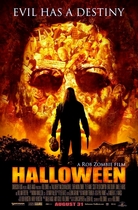Our editor-in-chief Nate Yapp is proud to have contributed to the new book Hidden Horror: A Celebration of 101 Underrated and Overlooked Fright Flicks, edited by Aaron Christensen. Another contributors include Anthony Timpone, B.J. Colangelo, Dave Alexander, Classic-Horror.com's own Robert C. Ring and John W. Bowen. Pick up a copy today from Amazon.com!
The Horror of Availability
Joseph Maddrey, author of the excellent "Nightmares in Red, White, and Blue: The Evolution of the American Horror Film" and occasional Classic-Horror contributor, has a thought-provoking post up at his blog about modern horror. To sum it up, he discusses the perceived "slump" in horror films and uses it as a jumping-off point to discuss why Rob Zombie's Halloween remake didn't work for him and why Anton Chigurh, Javier Bardem's character in No Country for Old Men, is a better horror movie villain despite not actually appearing in a horror movie.
All of this set my own mind a-wandering on why this might be -- why so much of the horror we see today is either a remake, sequel, or pastiche of the product of yesteryear, and why horror fans like myself prefer to cling to the genre's past to the detriment of its present. By the numbers, it doesn't make sense; even discounting direct-to-video and made-for-television fare, there have been more horror films produced this decade than were made cumulatively between 1896 (the beginning of cinema) and 1979. Classic-Horror can't even escape that fact -- the 2000s are the most review-heavy decade on this site.
Despite this, our eye remains firmly on the past, the "horror canon" as Maddrey's post puts it, and so do the eyes of the studios, large and small. I begin to wonder if this isn't the disease or a symptom of a larger problem. I wonder if it's actually an unfortunate side effect of something that is highly beneficial to the horror fan -- the increasing availability of the past.
Walk down this path with me for a bit (and please correct me on any historical inaccuracies -- this is coming off the cuff). At the beginning of cinema, movies traveled from town to town. Smaller towns would often get movies months and months after they premiered, if they got them at all. Two people with similar tastes in different locations might not see the same films. Once the studio system solidified, the studios controlled production, distribution, and exhibition of their own films and had a free hand to determine what the public saw. When you did see a film you liked, your only opportunity to see it again was while it was still at the movie theater. If you missed your opportunity, you had to hope that it was popular enough for a re-release, but that could take years.
Since then, the number of theaters has increased, as well as the numbers of screens in those theaters. Television has been added to the mix, going from three channels and a handful of Universal/Columbia titles in the late 1950s to near-infinite choices coming in through a cable or satellite dish, including channels like Sci-Fi Channel and MonstersHD devoted to fantastic cinema. Home video, which started with little 8mm and 16mm projectors in the 50s and 60s, has grown into an industry larger than theatrical exhibition. What we can't get on HD-DVD or Blu-ray, we can likely find on standard DVD. What we can't get there might be found on the now-ancient VHS format. We can download and watch high-quality movies on our computer screens through programs like iTunes. We can even carry those movies around with us in our pockets on our iPods.
The upshot of all of this is that horror fans can watch almost any horror film there is. The only limitations are time and money. At the same time, we are inundated with new product -- overwhelmed with it, in fact, while being resold movies we already own with new special features or remastered transfers. So we cling to the past, because it's a known property and it has riches of which we are already aware (or for which there is more than enough critical documentation). Hollywood, which is wise to trends but rarely to the reasons behind them, makes films that exploit this. We become trapped in a vicious cycle, of course.
There is a Douglas Adams short story entitled "Young Zaphod Plays It Safe" which deals with the concept of "time mining" -- people from the future mining the energy of the past until the past becomes stagnant and the present dimmer. I think that's what we're running into here. We as consumers are just as responsible as the studios -- we must learn to become excited and unironically joyful about the prospects of the future to maintain its viability as a source of new pasts. Without this, we are surely doomed to an endless repetition of increasingly diminishing returns.
You may find it odd that a site that expounds the joys of the classics would take such an approach, but our interest has always been in horror. We believe that the past is the best place to learn, but the future will always be a more interesting place to look. Only by balancing the two can we hope to move forward and discover new tales of terror and new ways of telling them.







